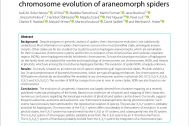Year
2021Authors
RNDr. František Šťáhlavský, Ph.D.doc. RNDr. Jiří Král, Dr.
Mgr. Martin Forman
Mgr. Matyáš Hiřman
Mgr. Pavel Just
Content
Background: Despite progress in genomic analysis of spiders, their chromosome evolution is not satisfactorily understood. Most information on spider chromosomes concerns the most diversified clade, entelegyne araneomorphs. Other clades are far less studied. Our study focused on haplogyne araneomorphs, which are remarkable for their unusual sex chromosome systems and for the co-evolution of sex chromosomes and nucleolus organizer regions (NORs)
some haplogynes exhibit holokinetic chromosomes. To trace the karyotype evolution of haplogynes on the family level, we analysed the number and morphology of chromosomes, sex chromosomes, NORs, and meiosis in pholcids, which are among the most diverse haplogyne families. The evolution of spider NORs is largely unknown.
Results: Our study is based on an extensive set of species representing all major pholcid clades. Pholcids exhibit a low 2n and predominance of biarmed chromosomes, which are typical haplogyne features. Sex chromosomes and NOR patterns of pholcids are diversified. We revealed six sex chromosome systems in pholcids (X0, XY, X 1 X 2 0, X 1 X 2 X 3 0, X 1 X 2 Y, and X 1 X 2 X 3 X 4 Y). The number of NOR loci ranges from one to nine. In some clades, NORs are also found on sex chromosomes.
Conclusions: The evolution of cytogenetic characters was largely derived from character mapping on a recently published molecular phylogeny of the family. Based on an extensive set of species and mapping of their characters, numerous conclusions regarding the karyotype evolution of pholcids and spiders can be drawn. Our results suggest frequent autosome–autosome and autosome–sex chromosome rearrangements during pholcid evolution. Such events have previously been attributed to the reproductive isolation of species. The peculiar X 1 X 2 Y system is probably ancestral for haplogynes. Chromosomes of the X 1 X 2 Y system differ considerably in their pattern of evolution. In some pholcid clades, the X 1 X 2 Y system has transformed into the X 1 X 2 0 or XY systems, and subsequently into the X0 system. The X 1 X 2 X 3 0 system of Smeringopus pallidus probably arose from the X 1 X 2 0 system by an X chromosome fission. The X 1 X 2 X 3 X 4 Y system of Kambiwa probably evolved from the X 1 X 2 Y system by integration of a chromosome pair.



